Analysis of Tesco's International Marketing Strategies and Entry Modes
VerifiedAdded on 2020/01/06
|13
|4272
|36
Report
AI Summary
This report offers a comprehensive analysis of Tesco's international marketing strategies. It begins with an introduction to Tesco, followed by an organizational analysis using SWOT. The report then explores Tesco's international market entry strategies, including its use of joint ventures, and its international market positioning strategy. The report also delves into Tesco's international marketing strategies, covering product, price, place, and promotion. The second task of the report focuses on a PESTLE analysis of India as a potential market for Tesco, and recommends the best entry mode for the company. The report concludes with a summary of findings and recommendations, highlighting the potential of the Indian market for Tesco's expansion.
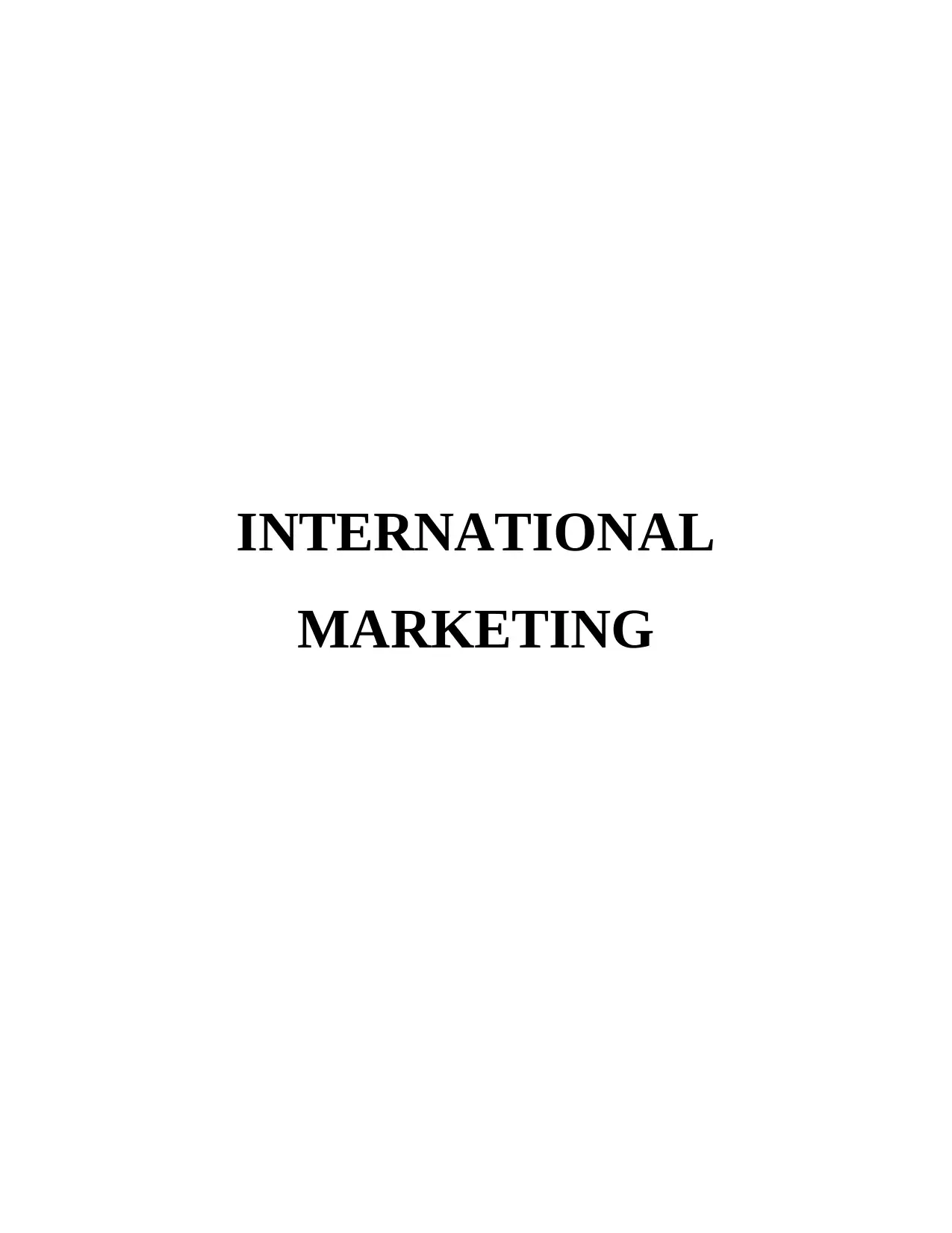
INTERNATIONAL
MARKETING
MARKETING
Paraphrase This Document
Need a fresh take? Get an instant paraphrase of this document with our AI Paraphraser
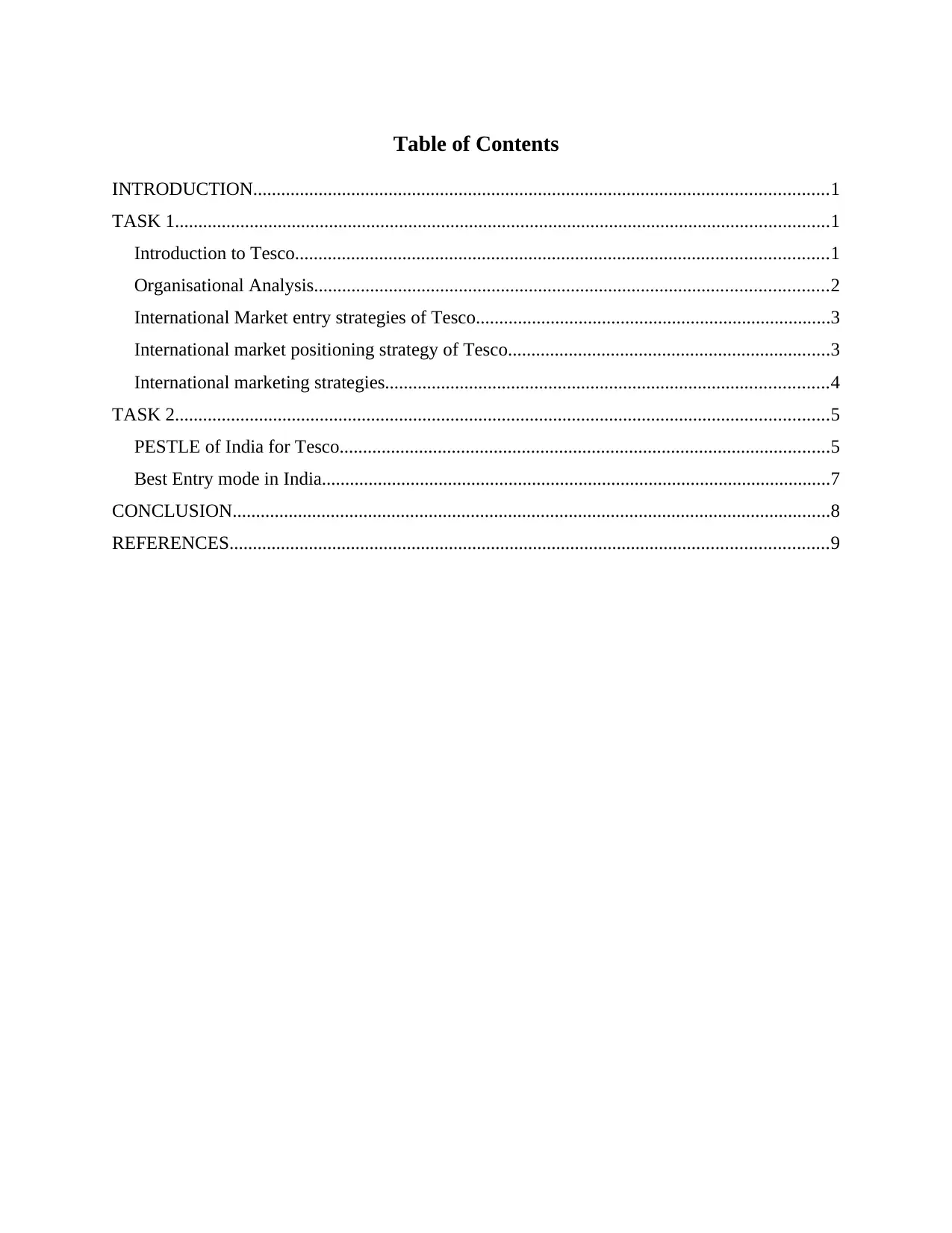
Table of Contents
INTRODUCTION...........................................................................................................................1
TASK 1............................................................................................................................................1
Introduction to Tesco..................................................................................................................1
Organisational Analysis..............................................................................................................2
International Market entry strategies of Tesco............................................................................3
International market positioning strategy of Tesco.....................................................................3
International marketing strategies...............................................................................................4
TASK 2............................................................................................................................................5
PESTLE of India for Tesco.........................................................................................................5
Best Entry mode in India.............................................................................................................7
CONCLUSION................................................................................................................................8
REFERENCES................................................................................................................................9
INTRODUCTION...........................................................................................................................1
TASK 1............................................................................................................................................1
Introduction to Tesco..................................................................................................................1
Organisational Analysis..............................................................................................................2
International Market entry strategies of Tesco............................................................................3
International market positioning strategy of Tesco.....................................................................3
International marketing strategies...............................................................................................4
TASK 2............................................................................................................................................5
PESTLE of India for Tesco.........................................................................................................5
Best Entry mode in India.............................................................................................................7
CONCLUSION................................................................................................................................8
REFERENCES................................................................................................................................9

⊘ This is a preview!⊘
Do you want full access?
Subscribe today to unlock all pages.

Trusted by 1+ million students worldwide
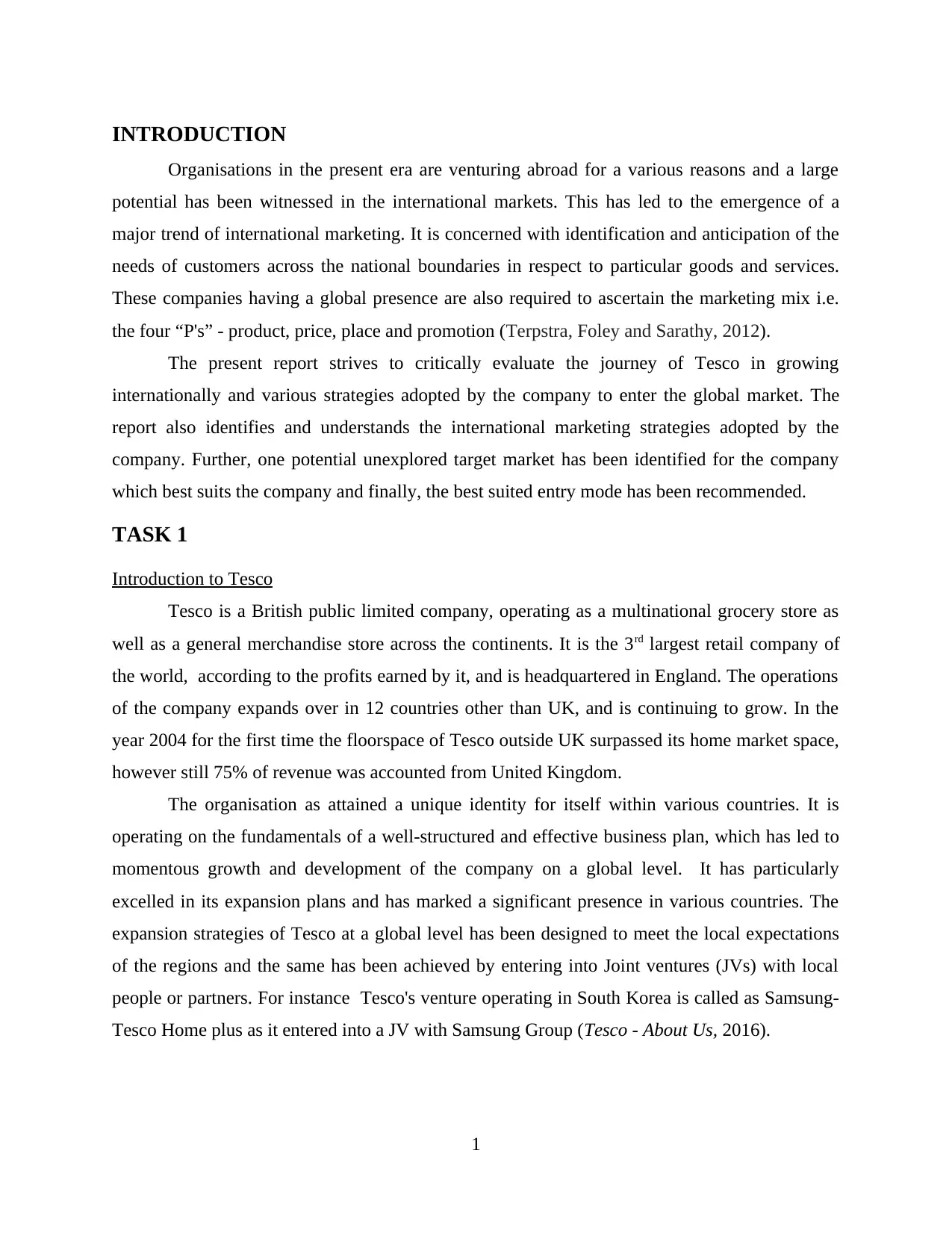
INTRODUCTION
Organisations in the present era are venturing abroad for a various reasons and a large
potential has been witnessed in the international markets. This has led to the emergence of a
major trend of international marketing. It is concerned with identification and anticipation of the
needs of customers across the national boundaries in respect to particular goods and services.
These companies having a global presence are also required to ascertain the marketing mix i.e.
the four “P's” - product, price, place and promotion (Terpstra, Foley and Sarathy, 2012).
The present report strives to critically evaluate the journey of Tesco in growing
internationally and various strategies adopted by the company to enter the global market. The
report also identifies and understands the international marketing strategies adopted by the
company. Further, one potential unexplored target market has been identified for the company
which best suits the company and finally, the best suited entry mode has been recommended.
TASK 1
Introduction to Tesco
Tesco is a British public limited company, operating as a multinational grocery store as
well as a general merchandise store across the continents. It is the 3rd largest retail company of
the world, according to the profits earned by it, and is headquartered in England. The operations
of the company expands over in 12 countries other than UK, and is continuing to grow. In the
year 2004 for the first time the floorspace of Tesco outside UK surpassed its home market space,
however still 75% of revenue was accounted from United Kingdom.
The organisation as attained a unique identity for itself within various countries. It is
operating on the fundamentals of a well-structured and effective business plan, which has led to
momentous growth and development of the company on a global level. It has particularly
excelled in its expansion plans and has marked a significant presence in various countries. The
expansion strategies of Tesco at a global level has been designed to meet the local expectations
of the regions and the same has been achieved by entering into Joint ventures (JVs) with local
people or partners. For instance Tesco's venture operating in South Korea is called as Samsung-
Tesco Home plus as it entered into a JV with Samsung Group (Tesco - About Us, 2016).
1
Organisations in the present era are venturing abroad for a various reasons and a large
potential has been witnessed in the international markets. This has led to the emergence of a
major trend of international marketing. It is concerned with identification and anticipation of the
needs of customers across the national boundaries in respect to particular goods and services.
These companies having a global presence are also required to ascertain the marketing mix i.e.
the four “P's” - product, price, place and promotion (Terpstra, Foley and Sarathy, 2012).
The present report strives to critically evaluate the journey of Tesco in growing
internationally and various strategies adopted by the company to enter the global market. The
report also identifies and understands the international marketing strategies adopted by the
company. Further, one potential unexplored target market has been identified for the company
which best suits the company and finally, the best suited entry mode has been recommended.
TASK 1
Introduction to Tesco
Tesco is a British public limited company, operating as a multinational grocery store as
well as a general merchandise store across the continents. It is the 3rd largest retail company of
the world, according to the profits earned by it, and is headquartered in England. The operations
of the company expands over in 12 countries other than UK, and is continuing to grow. In the
year 2004 for the first time the floorspace of Tesco outside UK surpassed its home market space,
however still 75% of revenue was accounted from United Kingdom.
The organisation as attained a unique identity for itself within various countries. It is
operating on the fundamentals of a well-structured and effective business plan, which has led to
momentous growth and development of the company on a global level. It has particularly
excelled in its expansion plans and has marked a significant presence in various countries. The
expansion strategies of Tesco at a global level has been designed to meet the local expectations
of the regions and the same has been achieved by entering into Joint ventures (JVs) with local
people or partners. For instance Tesco's venture operating in South Korea is called as Samsung-
Tesco Home plus as it entered into a JV with Samsung Group (Tesco - About Us, 2016).
1
Paraphrase This Document
Need a fresh take? Get an instant paraphrase of this document with our AI Paraphraser
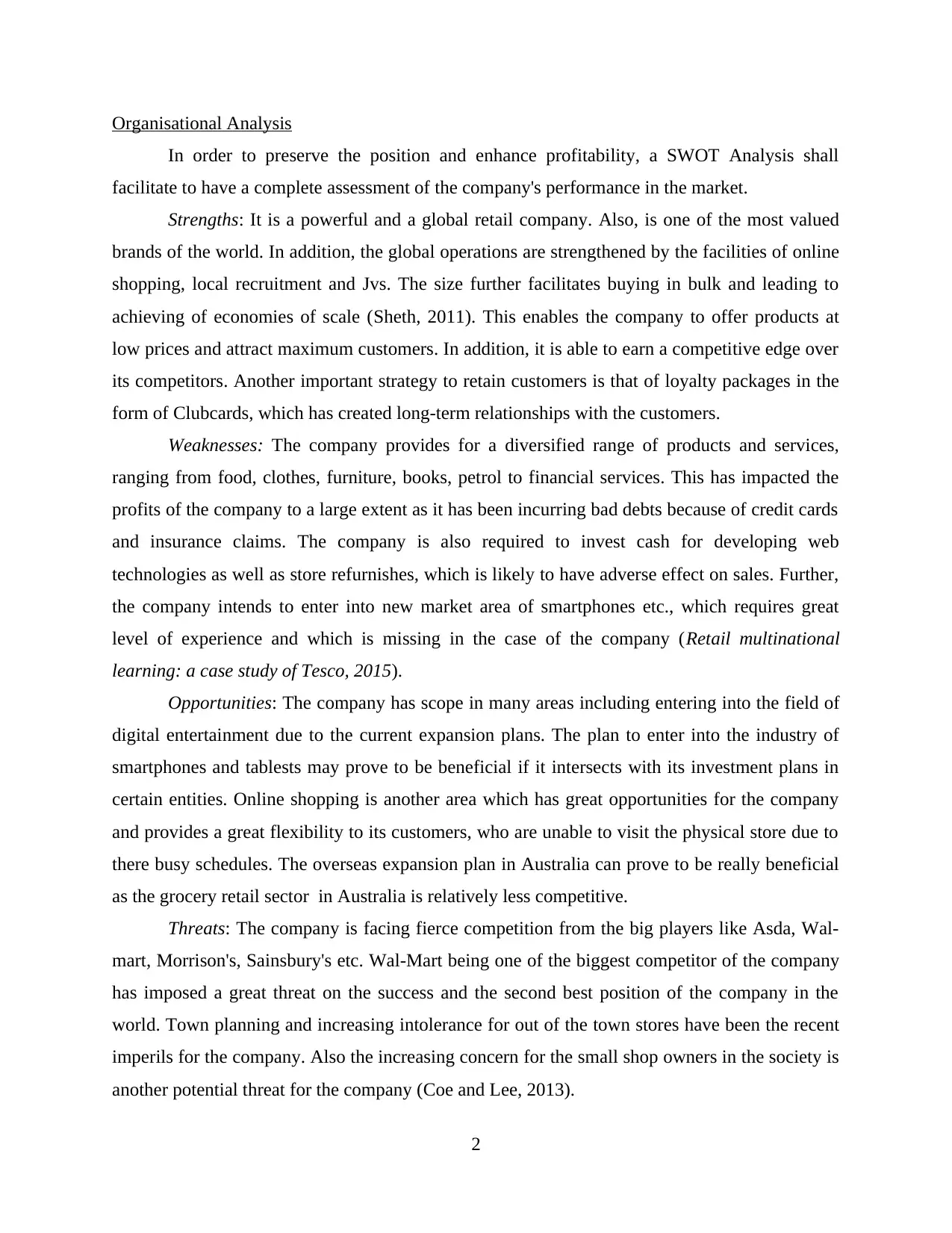
Organisational Analysis
In order to preserve the position and enhance profitability, a SWOT Analysis shall
facilitate to have a complete assessment of the company's performance in the market.
Strengths: It is a powerful and a global retail company. Also, is one of the most valued
brands of the world. In addition, the global operations are strengthened by the facilities of online
shopping, local recruitment and Jvs. The size further facilitates buying in bulk and leading to
achieving of economies of scale (Sheth, 2011). This enables the company to offer products at
low prices and attract maximum customers. In addition, it is able to earn a competitive edge over
its competitors. Another important strategy to retain customers is that of loyalty packages in the
form of Clubcards, which has created long-term relationships with the customers.
Weaknesses: The company provides for a diversified range of products and services,
ranging from food, clothes, furniture, books, petrol to financial services. This has impacted the
profits of the company to a large extent as it has been incurring bad debts because of credit cards
and insurance claims. The company is also required to invest cash for developing web
technologies as well as store refurnishes, which is likely to have adverse effect on sales. Further,
the company intends to enter into new market area of smartphones etc., which requires great
level of experience and which is missing in the case of the company (Retail multinational
learning: a case study of Tesco, 2015).
Opportunities: The company has scope in many areas including entering into the field of
digital entertainment due to the current expansion plans. The plan to enter into the industry of
smartphones and tablests may prove to be beneficial if it intersects with its investment plans in
certain entities. Online shopping is another area which has great opportunities for the company
and provides a great flexibility to its customers, who are unable to visit the physical store due to
there busy schedules. The overseas expansion plan in Australia can prove to be really beneficial
as the grocery retail sector in Australia is relatively less competitive.
Threats: The company is facing fierce competition from the big players like Asda, Wal-
mart, Morrison's, Sainsbury's etc. Wal-Mart being one of the biggest competitor of the company
has imposed a great threat on the success and the second best position of the company in the
world. Town planning and increasing intolerance for out of the town stores have been the recent
imperils for the company. Also the increasing concern for the small shop owners in the society is
another potential threat for the company (Coe and Lee, 2013).
2
In order to preserve the position and enhance profitability, a SWOT Analysis shall
facilitate to have a complete assessment of the company's performance in the market.
Strengths: It is a powerful and a global retail company. Also, is one of the most valued
brands of the world. In addition, the global operations are strengthened by the facilities of online
shopping, local recruitment and Jvs. The size further facilitates buying in bulk and leading to
achieving of economies of scale (Sheth, 2011). This enables the company to offer products at
low prices and attract maximum customers. In addition, it is able to earn a competitive edge over
its competitors. Another important strategy to retain customers is that of loyalty packages in the
form of Clubcards, which has created long-term relationships with the customers.
Weaknesses: The company provides for a diversified range of products and services,
ranging from food, clothes, furniture, books, petrol to financial services. This has impacted the
profits of the company to a large extent as it has been incurring bad debts because of credit cards
and insurance claims. The company is also required to invest cash for developing web
technologies as well as store refurnishes, which is likely to have adverse effect on sales. Further,
the company intends to enter into new market area of smartphones etc., which requires great
level of experience and which is missing in the case of the company (Retail multinational
learning: a case study of Tesco, 2015).
Opportunities: The company has scope in many areas including entering into the field of
digital entertainment due to the current expansion plans. The plan to enter into the industry of
smartphones and tablests may prove to be beneficial if it intersects with its investment plans in
certain entities. Online shopping is another area which has great opportunities for the company
and provides a great flexibility to its customers, who are unable to visit the physical store due to
there busy schedules. The overseas expansion plan in Australia can prove to be really beneficial
as the grocery retail sector in Australia is relatively less competitive.
Threats: The company is facing fierce competition from the big players like Asda, Wal-
mart, Morrison's, Sainsbury's etc. Wal-Mart being one of the biggest competitor of the company
has imposed a great threat on the success and the second best position of the company in the
world. Town planning and increasing intolerance for out of the town stores have been the recent
imperils for the company. Also the increasing concern for the small shop owners in the society is
another potential threat for the company (Coe and Lee, 2013).
2
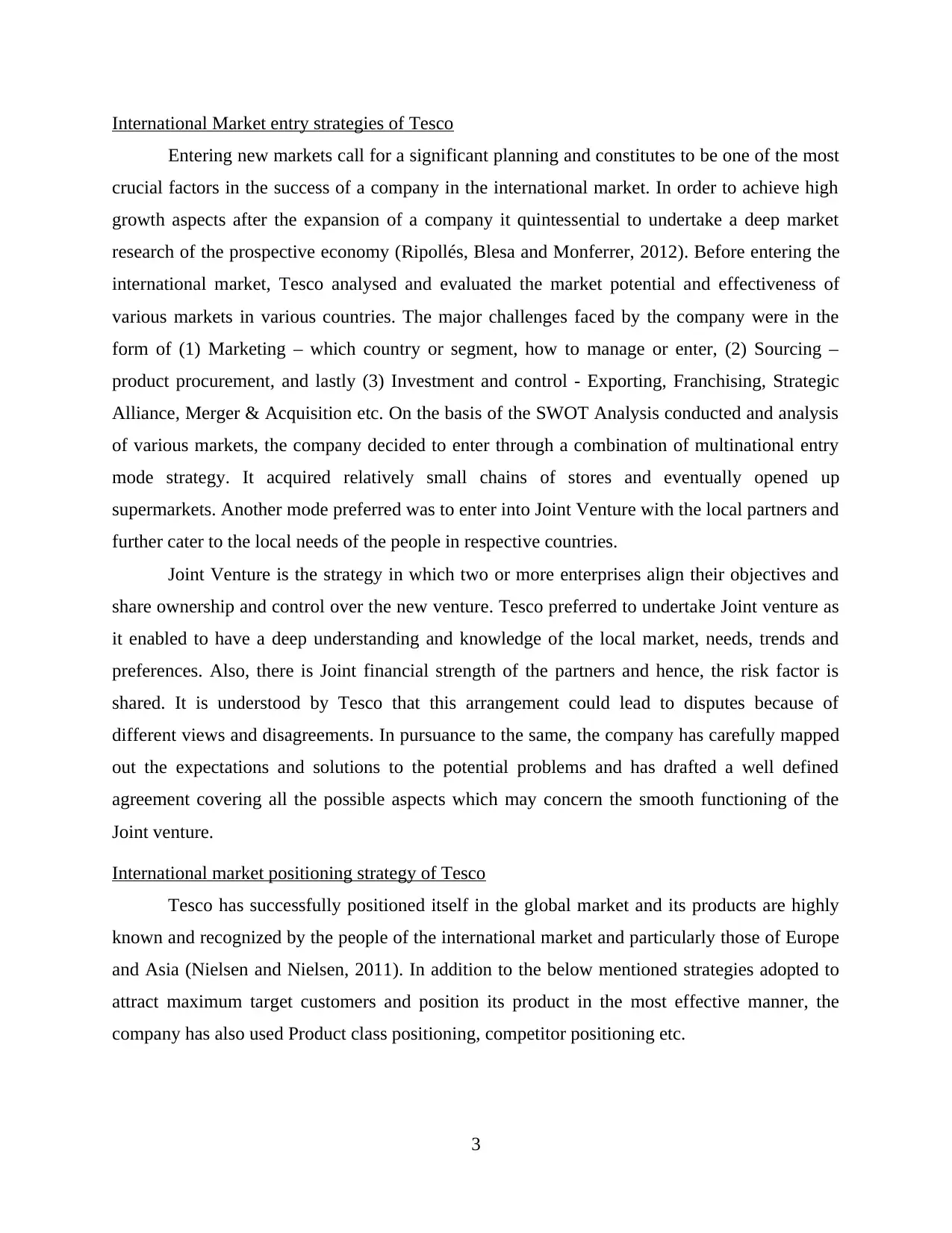
International Market entry strategies of Tesco
Entering new markets call for a significant planning and constitutes to be one of the most
crucial factors in the success of a company in the international market. In order to achieve high
growth aspects after the expansion of a company it quintessential to undertake a deep market
research of the prospective economy (Ripollés, Blesa and Monferrer, 2012). Before entering the
international market, Tesco analysed and evaluated the market potential and effectiveness of
various markets in various countries. The major challenges faced by the company were in the
form of (1) Marketing – which country or segment, how to manage or enter, (2) Sourcing –
product procurement, and lastly (3) Investment and control - Exporting, Franchising, Strategic
Alliance, Merger & Acquisition etc. On the basis of the SWOT Analysis conducted and analysis
of various markets, the company decided to enter through a combination of multinational entry
mode strategy. It acquired relatively small chains of stores and eventually opened up
supermarkets. Another mode preferred was to enter into Joint Venture with the local partners and
further cater to the local needs of the people in respective countries.
Joint Venture is the strategy in which two or more enterprises align their objectives and
share ownership and control over the new venture. Tesco preferred to undertake Joint venture as
it enabled to have a deep understanding and knowledge of the local market, needs, trends and
preferences. Also, there is Joint financial strength of the partners and hence, the risk factor is
shared. It is understood by Tesco that this arrangement could lead to disputes because of
different views and disagreements. In pursuance to the same, the company has carefully mapped
out the expectations and solutions to the potential problems and has drafted a well defined
agreement covering all the possible aspects which may concern the smooth functioning of the
Joint venture.
International market positioning strategy of Tesco
Tesco has successfully positioned itself in the global market and its products are highly
known and recognized by the people of the international market and particularly those of Europe
and Asia (Nielsen and Nielsen, 2011). In addition to the below mentioned strategies adopted to
attract maximum target customers and position its product in the most effective manner, the
company has also used Product class positioning, competitor positioning etc.
3
Entering new markets call for a significant planning and constitutes to be one of the most
crucial factors in the success of a company in the international market. In order to achieve high
growth aspects after the expansion of a company it quintessential to undertake a deep market
research of the prospective economy (Ripollés, Blesa and Monferrer, 2012). Before entering the
international market, Tesco analysed and evaluated the market potential and effectiveness of
various markets in various countries. The major challenges faced by the company were in the
form of (1) Marketing – which country or segment, how to manage or enter, (2) Sourcing –
product procurement, and lastly (3) Investment and control - Exporting, Franchising, Strategic
Alliance, Merger & Acquisition etc. On the basis of the SWOT Analysis conducted and analysis
of various markets, the company decided to enter through a combination of multinational entry
mode strategy. It acquired relatively small chains of stores and eventually opened up
supermarkets. Another mode preferred was to enter into Joint Venture with the local partners and
further cater to the local needs of the people in respective countries.
Joint Venture is the strategy in which two or more enterprises align their objectives and
share ownership and control over the new venture. Tesco preferred to undertake Joint venture as
it enabled to have a deep understanding and knowledge of the local market, needs, trends and
preferences. Also, there is Joint financial strength of the partners and hence, the risk factor is
shared. It is understood by Tesco that this arrangement could lead to disputes because of
different views and disagreements. In pursuance to the same, the company has carefully mapped
out the expectations and solutions to the potential problems and has drafted a well defined
agreement covering all the possible aspects which may concern the smooth functioning of the
Joint venture.
International market positioning strategy of Tesco
Tesco has successfully positioned itself in the global market and its products are highly
known and recognized by the people of the international market and particularly those of Europe
and Asia (Nielsen and Nielsen, 2011). In addition to the below mentioned strategies adopted to
attract maximum target customers and position its product in the most effective manner, the
company has also used Product class positioning, competitor positioning etc.
3
⊘ This is a preview!⊘
Do you want full access?
Subscribe today to unlock all pages.

Trusted by 1+ million students worldwide
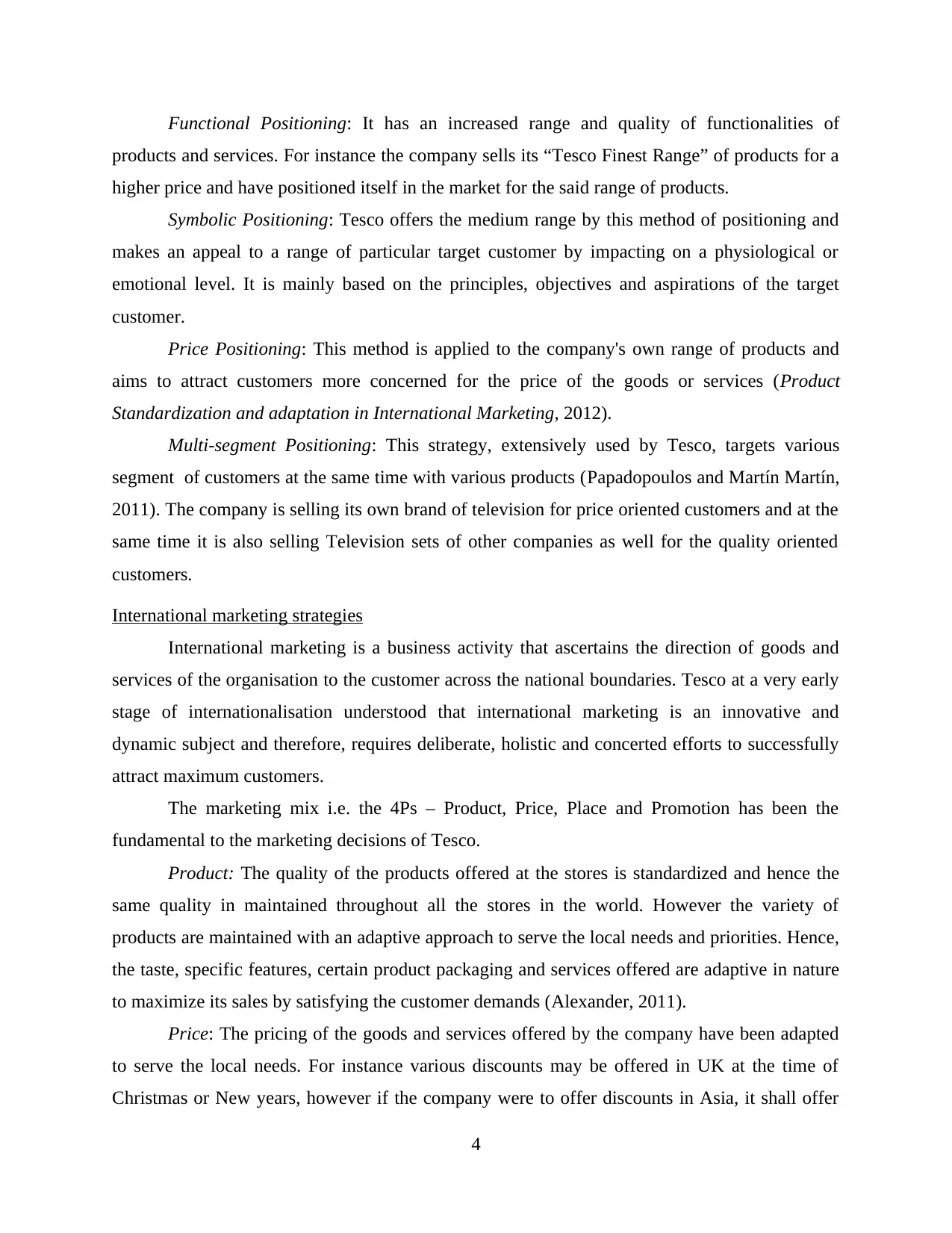
Functional Positioning: It has an increased range and quality of functionalities of
products and services. For instance the company sells its “Tesco Finest Range” of products for a
higher price and have positioned itself in the market for the said range of products.
Symbolic Positioning: Tesco offers the medium range by this method of positioning and
makes an appeal to a range of particular target customer by impacting on a physiological or
emotional level. It is mainly based on the principles, objectives and aspirations of the target
customer.
Price Positioning: This method is applied to the company's own range of products and
aims to attract customers more concerned for the price of the goods or services (Product
Standardization and adaptation in International Marketing, 2012).
Multi-segment Positioning: This strategy, extensively used by Tesco, targets various
segment of customers at the same time with various products (Papadopoulos and Martín Martín,
2011). The company is selling its own brand of television for price oriented customers and at the
same time it is also selling Television sets of other companies as well for the quality oriented
customers.
International marketing strategies
International marketing is a business activity that ascertains the direction of goods and
services of the organisation to the customer across the national boundaries. Tesco at a very early
stage of internationalisation understood that international marketing is an innovative and
dynamic subject and therefore, requires deliberate, holistic and concerted efforts to successfully
attract maximum customers.
The marketing mix i.e. the 4Ps – Product, Price, Place and Promotion has been the
fundamental to the marketing decisions of Tesco.
Product: The quality of the products offered at the stores is standardized and hence the
same quality in maintained throughout all the stores in the world. However the variety of
products are maintained with an adaptive approach to serve the local needs and priorities. Hence,
the taste, specific features, certain product packaging and services offered are adaptive in nature
to maximize its sales by satisfying the customer demands (Alexander, 2011).
Price: The pricing of the goods and services offered by the company have been adapted
to serve the local needs. For instance various discounts may be offered in UK at the time of
Christmas or New years, however if the company were to offer discounts in Asia, it shall offer
4
products and services. For instance the company sells its “Tesco Finest Range” of products for a
higher price and have positioned itself in the market for the said range of products.
Symbolic Positioning: Tesco offers the medium range by this method of positioning and
makes an appeal to a range of particular target customer by impacting on a physiological or
emotional level. It is mainly based on the principles, objectives and aspirations of the target
customer.
Price Positioning: This method is applied to the company's own range of products and
aims to attract customers more concerned for the price of the goods or services (Product
Standardization and adaptation in International Marketing, 2012).
Multi-segment Positioning: This strategy, extensively used by Tesco, targets various
segment of customers at the same time with various products (Papadopoulos and Martín Martín,
2011). The company is selling its own brand of television for price oriented customers and at the
same time it is also selling Television sets of other companies as well for the quality oriented
customers.
International marketing strategies
International marketing is a business activity that ascertains the direction of goods and
services of the organisation to the customer across the national boundaries. Tesco at a very early
stage of internationalisation understood that international marketing is an innovative and
dynamic subject and therefore, requires deliberate, holistic and concerted efforts to successfully
attract maximum customers.
The marketing mix i.e. the 4Ps – Product, Price, Place and Promotion has been the
fundamental to the marketing decisions of Tesco.
Product: The quality of the products offered at the stores is standardized and hence the
same quality in maintained throughout all the stores in the world. However the variety of
products are maintained with an adaptive approach to serve the local needs and priorities. Hence,
the taste, specific features, certain product packaging and services offered are adaptive in nature
to maximize its sales by satisfying the customer demands (Alexander, 2011).
Price: The pricing of the goods and services offered by the company have been adapted
to serve the local needs. For instance various discounts may be offered in UK at the time of
Christmas or New years, however if the company were to offer discounts in Asia, it shall offer
4
Paraphrase This Document
Need a fresh take? Get an instant paraphrase of this document with our AI Paraphraser
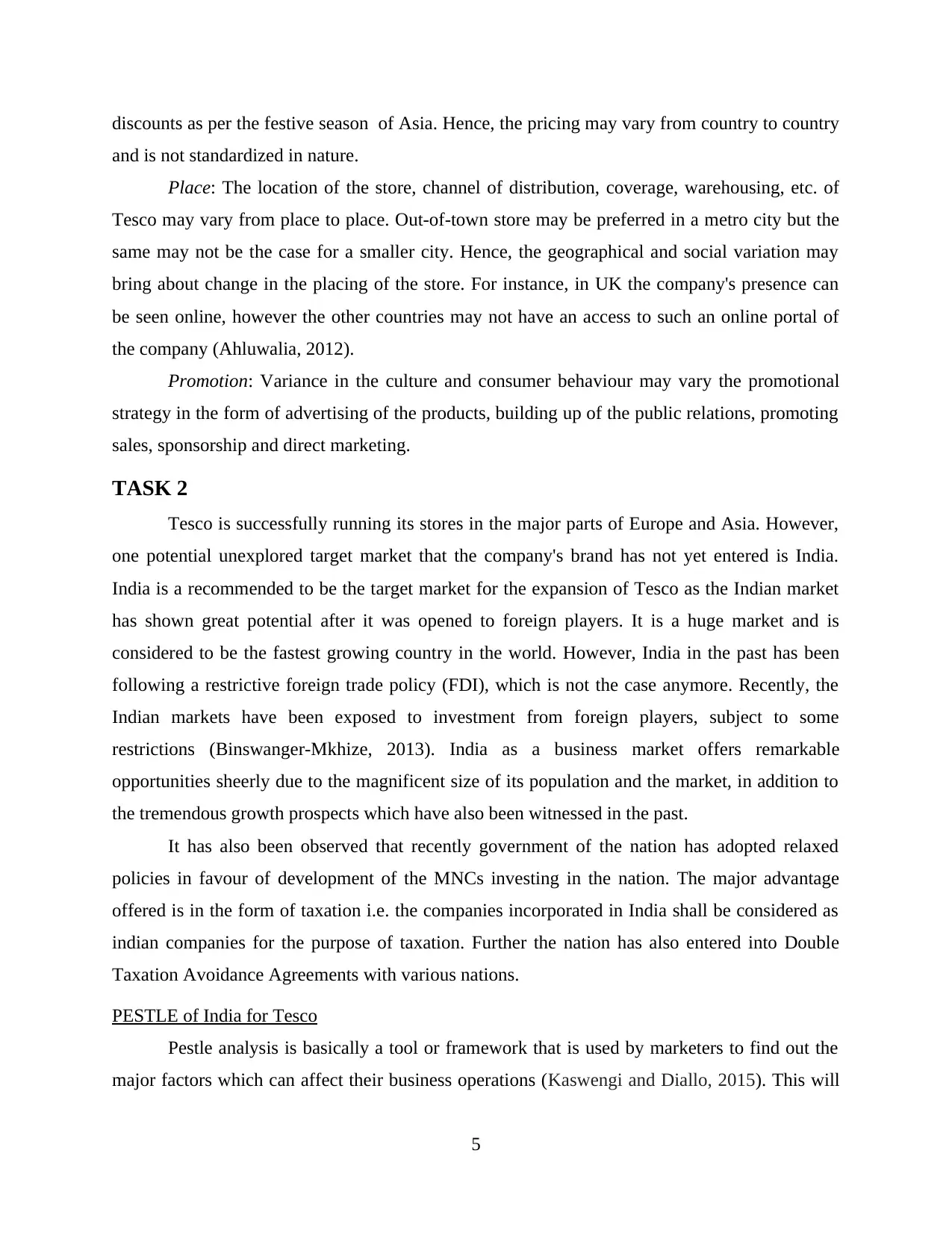
discounts as per the festive season of Asia. Hence, the pricing may vary from country to country
and is not standardized in nature.
Place: The location of the store, channel of distribution, coverage, warehousing, etc. of
Tesco may vary from place to place. Out-of-town store may be preferred in a metro city but the
same may not be the case for a smaller city. Hence, the geographical and social variation may
bring about change in the placing of the store. For instance, in UK the company's presence can
be seen online, however the other countries may not have an access to such an online portal of
the company (Ahluwalia, 2012).
Promotion: Variance in the culture and consumer behaviour may vary the promotional
strategy in the form of advertising of the products, building up of the public relations, promoting
sales, sponsorship and direct marketing.
TASK 2
Tesco is successfully running its stores in the major parts of Europe and Asia. However,
one potential unexplored target market that the company's brand has not yet entered is India.
India is a recommended to be the target market for the expansion of Tesco as the Indian market
has shown great potential after it was opened to foreign players. It is a huge market and is
considered to be the fastest growing country in the world. However, India in the past has been
following a restrictive foreign trade policy (FDI), which is not the case anymore. Recently, the
Indian markets have been exposed to investment from foreign players, subject to some
restrictions (Binswanger-Mkhize, 2013). India as a business market offers remarkable
opportunities sheerly due to the magnificent size of its population and the market, in addition to
the tremendous growth prospects which have also been witnessed in the past.
It has also been observed that recently government of the nation has adopted relaxed
policies in favour of development of the MNCs investing in the nation. The major advantage
offered is in the form of taxation i.e. the companies incorporated in India shall be considered as
indian companies for the purpose of taxation. Further the nation has also entered into Double
Taxation Avoidance Agreements with various nations.
PESTLE of India for Tesco
Pestle analysis is basically a tool or framework that is used by marketers to find out the
major factors which can affect their business operations (Kaswengi and Diallo, 2015). This will
5
and is not standardized in nature.
Place: The location of the store, channel of distribution, coverage, warehousing, etc. of
Tesco may vary from place to place. Out-of-town store may be preferred in a metro city but the
same may not be the case for a smaller city. Hence, the geographical and social variation may
bring about change in the placing of the store. For instance, in UK the company's presence can
be seen online, however the other countries may not have an access to such an online portal of
the company (Ahluwalia, 2012).
Promotion: Variance in the culture and consumer behaviour may vary the promotional
strategy in the form of advertising of the products, building up of the public relations, promoting
sales, sponsorship and direct marketing.
TASK 2
Tesco is successfully running its stores in the major parts of Europe and Asia. However,
one potential unexplored target market that the company's brand has not yet entered is India.
India is a recommended to be the target market for the expansion of Tesco as the Indian market
has shown great potential after it was opened to foreign players. It is a huge market and is
considered to be the fastest growing country in the world. However, India in the past has been
following a restrictive foreign trade policy (FDI), which is not the case anymore. Recently, the
Indian markets have been exposed to investment from foreign players, subject to some
restrictions (Binswanger-Mkhize, 2013). India as a business market offers remarkable
opportunities sheerly due to the magnificent size of its population and the market, in addition to
the tremendous growth prospects which have also been witnessed in the past.
It has also been observed that recently government of the nation has adopted relaxed
policies in favour of development of the MNCs investing in the nation. The major advantage
offered is in the form of taxation i.e. the companies incorporated in India shall be considered as
indian companies for the purpose of taxation. Further the nation has also entered into Double
Taxation Avoidance Agreements with various nations.
PESTLE of India for Tesco
Pestle analysis is basically a tool or framework that is used by marketers to find out the
major factors which can affect their business operations (Kaswengi and Diallo, 2015). This will
5
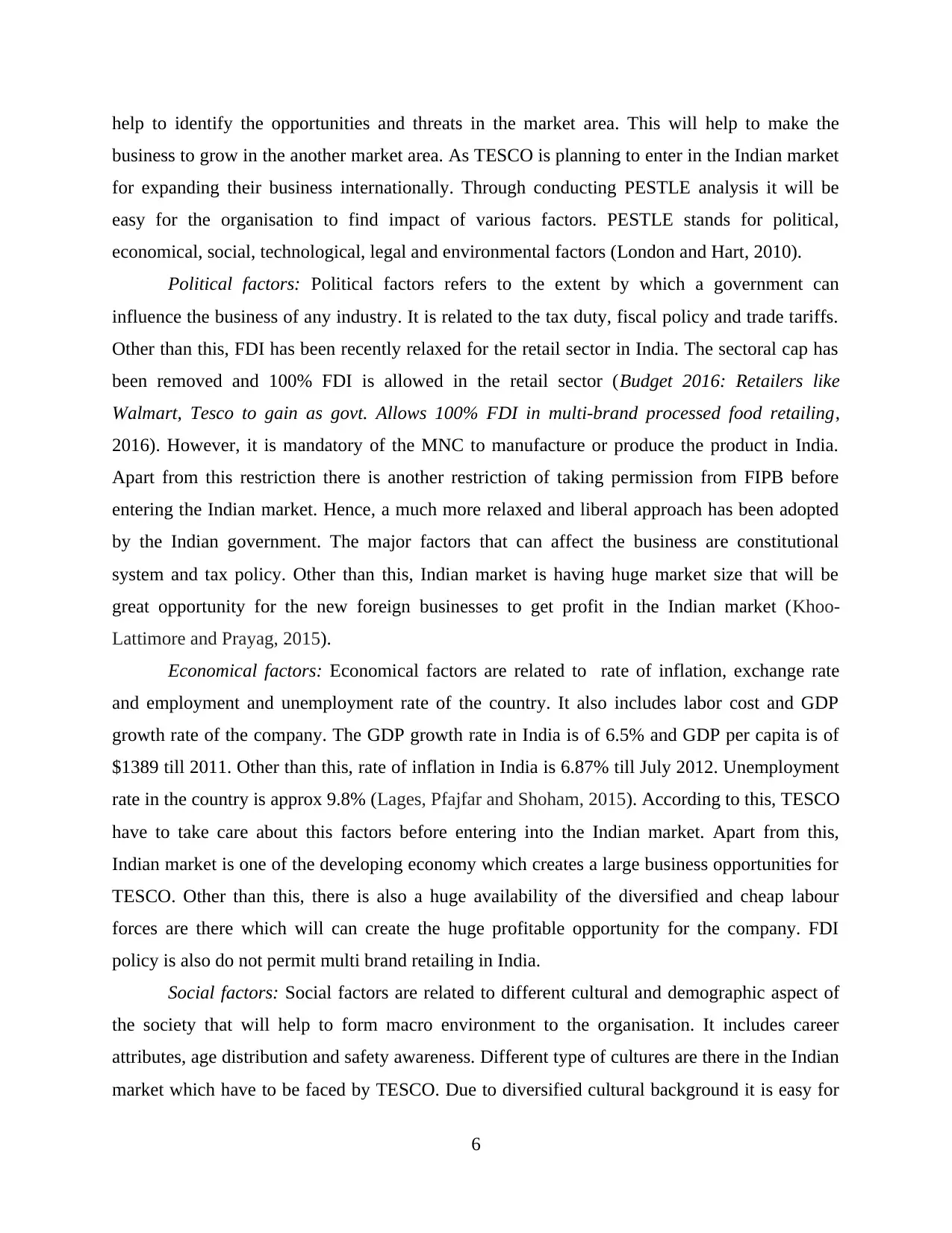
help to identify the opportunities and threats in the market area. This will help to make the
business to grow in the another market area. As TESCO is planning to enter in the Indian market
for expanding their business internationally. Through conducting PESTLE analysis it will be
easy for the organisation to find impact of various factors. PESTLE stands for political,
economical, social, technological, legal and environmental factors (London and Hart, 2010).
Political factors: Political factors refers to the extent by which a government can
influence the business of any industry. It is related to the tax duty, fiscal policy and trade tariffs.
Other than this, FDI has been recently relaxed for the retail sector in India. The sectoral cap has
been removed and 100% FDI is allowed in the retail sector (Budget 2016: Retailers like
Walmart, Tesco to gain as govt. Allows 100% FDI in multi-brand processed food retailing,
2016). However, it is mandatory of the MNC to manufacture or produce the product in India.
Apart from this restriction there is another restriction of taking permission from FIPB before
entering the Indian market. Hence, a much more relaxed and liberal approach has been adopted
by the Indian government. The major factors that can affect the business are constitutional
system and tax policy. Other than this, Indian market is having huge market size that will be
great opportunity for the new foreign businesses to get profit in the Indian market (Khoo-
Lattimore and Prayag, 2015).
Economical factors: Economical factors are related to rate of inflation, exchange rate
and employment and unemployment rate of the country. It also includes labor cost and GDP
growth rate of the company. The GDP growth rate in India is of 6.5% and GDP per capita is of
$1389 till 2011. Other than this, rate of inflation in India is 6.87% till July 2012. Unemployment
rate in the country is approx 9.8% (Lages, Pfajfar and Shoham, 2015). According to this, TESCO
have to take care about this factors before entering into the Indian market. Apart from this,
Indian market is one of the developing economy which creates a large business opportunities for
TESCO. Other than this, there is also a huge availability of the diversified and cheap labour
forces are there which will can create the huge profitable opportunity for the company. FDI
policy is also do not permit multi brand retailing in India.
Social factors: Social factors are related to different cultural and demographic aspect of
the society that will help to form macro environment to the organisation. It includes career
attributes, age distribution and safety awareness. Different type of cultures are there in the Indian
market which have to be faced by TESCO. Due to diversified cultural background it is easy for
6
business to grow in the another market area. As TESCO is planning to enter in the Indian market
for expanding their business internationally. Through conducting PESTLE analysis it will be
easy for the organisation to find impact of various factors. PESTLE stands for political,
economical, social, technological, legal and environmental factors (London and Hart, 2010).
Political factors: Political factors refers to the extent by which a government can
influence the business of any industry. It is related to the tax duty, fiscal policy and trade tariffs.
Other than this, FDI has been recently relaxed for the retail sector in India. The sectoral cap has
been removed and 100% FDI is allowed in the retail sector (Budget 2016: Retailers like
Walmart, Tesco to gain as govt. Allows 100% FDI in multi-brand processed food retailing,
2016). However, it is mandatory of the MNC to manufacture or produce the product in India.
Apart from this restriction there is another restriction of taking permission from FIPB before
entering the Indian market. Hence, a much more relaxed and liberal approach has been adopted
by the Indian government. The major factors that can affect the business are constitutional
system and tax policy. Other than this, Indian market is having huge market size that will be
great opportunity for the new foreign businesses to get profit in the Indian market (Khoo-
Lattimore and Prayag, 2015).
Economical factors: Economical factors are related to rate of inflation, exchange rate
and employment and unemployment rate of the country. It also includes labor cost and GDP
growth rate of the company. The GDP growth rate in India is of 6.5% and GDP per capita is of
$1389 till 2011. Other than this, rate of inflation in India is 6.87% till July 2012. Unemployment
rate in the country is approx 9.8% (Lages, Pfajfar and Shoham, 2015). According to this, TESCO
have to take care about this factors before entering into the Indian market. Apart from this,
Indian market is one of the developing economy which creates a large business opportunities for
TESCO. Other than this, there is also a huge availability of the diversified and cheap labour
forces are there which will can create the huge profitable opportunity for the company. FDI
policy is also do not permit multi brand retailing in India.
Social factors: Social factors are related to different cultural and demographic aspect of
the society that will help to form macro environment to the organisation. It includes career
attributes, age distribution and safety awareness. Different type of cultures are there in the Indian
market which have to be faced by TESCO. Due to diversified cultural background it is easy for
6
⊘ This is a preview!⊘
Do you want full access?
Subscribe today to unlock all pages.

Trusted by 1+ million students worldwide
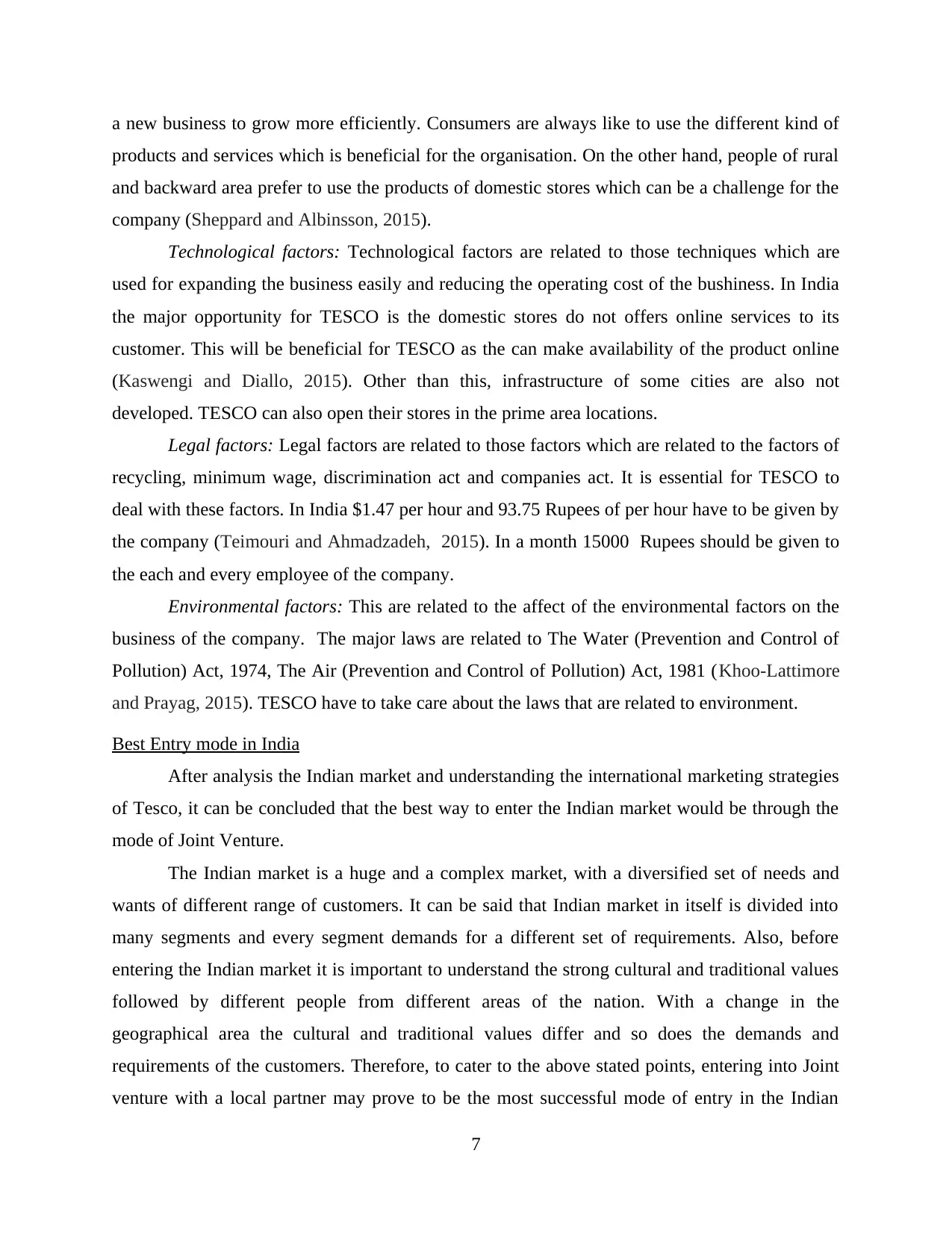
a new business to grow more efficiently. Consumers are always like to use the different kind of
products and services which is beneficial for the organisation. On the other hand, people of rural
and backward area prefer to use the products of domestic stores which can be a challenge for the
company (Sheppard and Albinsson, 2015).
Technological factors: Technological factors are related to those techniques which are
used for expanding the business easily and reducing the operating cost of the bushiness. In India
the major opportunity for TESCO is the domestic stores do not offers online services to its
customer. This will be beneficial for TESCO as the can make availability of the product online
(Kaswengi and Diallo, 2015). Other than this, infrastructure of some cities are also not
developed. TESCO can also open their stores in the prime area locations.
Legal factors: Legal factors are related to those factors which are related to the factors of
recycling, minimum wage, discrimination act and companies act. It is essential for TESCO to
deal with these factors. In India $1.47 per hour and 93.75 Rupees of per hour have to be given by
the company (Teimouri and Ahmadzadeh, 2015). In a month 15000 Rupees should be given to
the each and every employee of the company.
Environmental factors: This are related to the affect of the environmental factors on the
business of the company. The major laws are related to The Water (Prevention and Control of
Pollution) Act, 1974, The Air (Prevention and Control of Pollution) Act, 1981 (Khoo-Lattimore
and Prayag, 2015). TESCO have to take care about the laws that are related to environment.
Best Entry mode in India
After analysis the Indian market and understanding the international marketing strategies
of Tesco, it can be concluded that the best way to enter the Indian market would be through the
mode of Joint Venture.
The Indian market is a huge and a complex market, with a diversified set of needs and
wants of different range of customers. It can be said that Indian market in itself is divided into
many segments and every segment demands for a different set of requirements. Also, before
entering the Indian market it is important to understand the strong cultural and traditional values
followed by different people from different areas of the nation. With a change in the
geographical area the cultural and traditional values differ and so does the demands and
requirements of the customers. Therefore, to cater to the above stated points, entering into Joint
venture with a local partner may prove to be the most successful mode of entry in the Indian
7
products and services which is beneficial for the organisation. On the other hand, people of rural
and backward area prefer to use the products of domestic stores which can be a challenge for the
company (Sheppard and Albinsson, 2015).
Technological factors: Technological factors are related to those techniques which are
used for expanding the business easily and reducing the operating cost of the bushiness. In India
the major opportunity for TESCO is the domestic stores do not offers online services to its
customer. This will be beneficial for TESCO as the can make availability of the product online
(Kaswengi and Diallo, 2015). Other than this, infrastructure of some cities are also not
developed. TESCO can also open their stores in the prime area locations.
Legal factors: Legal factors are related to those factors which are related to the factors of
recycling, minimum wage, discrimination act and companies act. It is essential for TESCO to
deal with these factors. In India $1.47 per hour and 93.75 Rupees of per hour have to be given by
the company (Teimouri and Ahmadzadeh, 2015). In a month 15000 Rupees should be given to
the each and every employee of the company.
Environmental factors: This are related to the affect of the environmental factors on the
business of the company. The major laws are related to The Water (Prevention and Control of
Pollution) Act, 1974, The Air (Prevention and Control of Pollution) Act, 1981 (Khoo-Lattimore
and Prayag, 2015). TESCO have to take care about the laws that are related to environment.
Best Entry mode in India
After analysis the Indian market and understanding the international marketing strategies
of Tesco, it can be concluded that the best way to enter the Indian market would be through the
mode of Joint Venture.
The Indian market is a huge and a complex market, with a diversified set of needs and
wants of different range of customers. It can be said that Indian market in itself is divided into
many segments and every segment demands for a different set of requirements. Also, before
entering the Indian market it is important to understand the strong cultural and traditional values
followed by different people from different areas of the nation. With a change in the
geographical area the cultural and traditional values differ and so does the demands and
requirements of the customers. Therefore, to cater to the above stated points, entering into Joint
venture with a local partner may prove to be the most successful mode of entry in the Indian
7
Paraphrase This Document
Need a fresh take? Get an instant paraphrase of this document with our AI Paraphraser
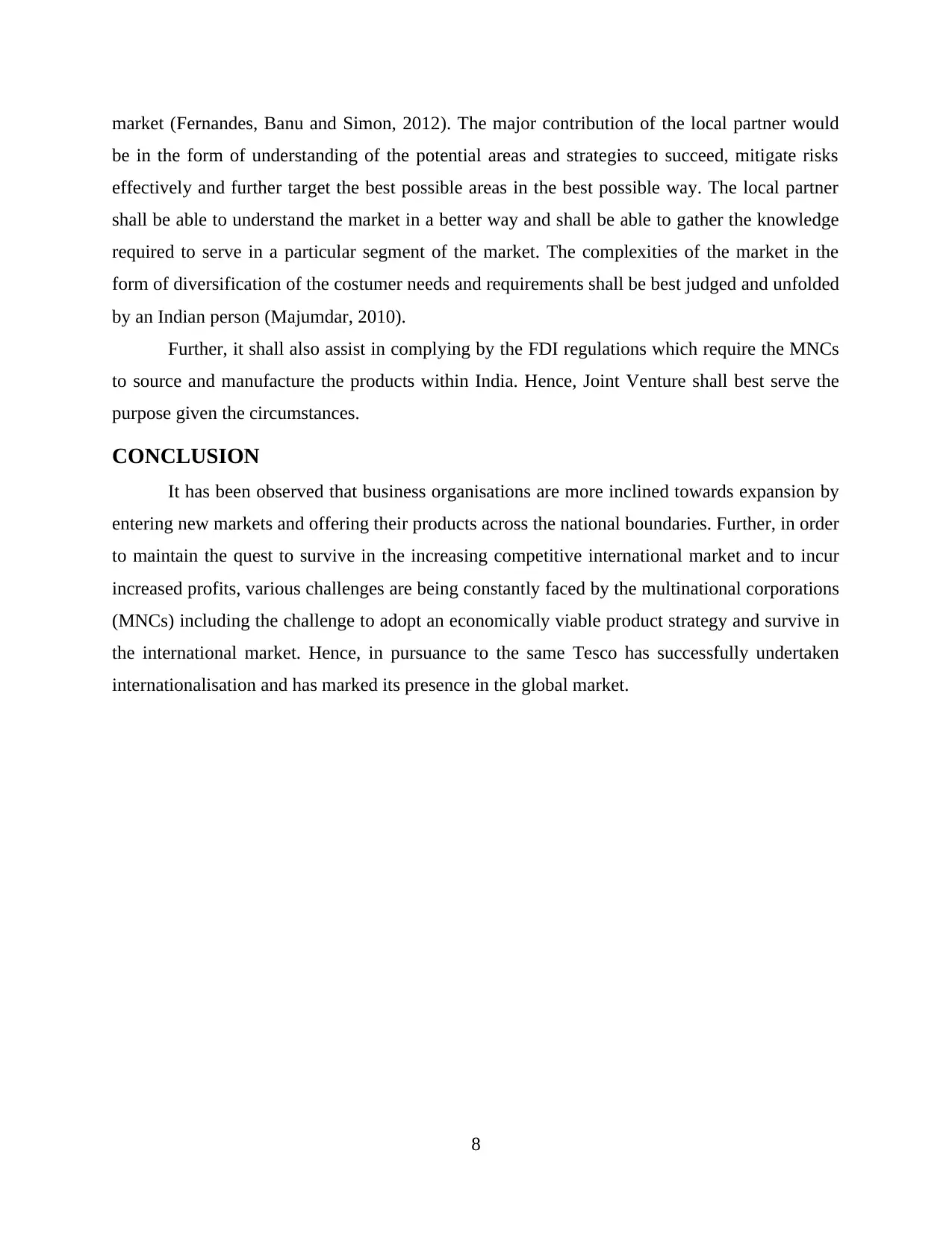
market (Fernandes, Banu and Simon, 2012). The major contribution of the local partner would
be in the form of understanding of the potential areas and strategies to succeed, mitigate risks
effectively and further target the best possible areas in the best possible way. The local partner
shall be able to understand the market in a better way and shall be able to gather the knowledge
required to serve in a particular segment of the market. The complexities of the market in the
form of diversification of the costumer needs and requirements shall be best judged and unfolded
by an Indian person (Majumdar, 2010).
Further, it shall also assist in complying by the FDI regulations which require the MNCs
to source and manufacture the products within India. Hence, Joint Venture shall best serve the
purpose given the circumstances.
CONCLUSION
It has been observed that business organisations are more inclined towards expansion by
entering new markets and offering their products across the national boundaries. Further, in order
to maintain the quest to survive in the increasing competitive international market and to incur
increased profits, various challenges are being constantly faced by the multinational corporations
(MNCs) including the challenge to adopt an economically viable product strategy and survive in
the international market. Hence, in pursuance to the same Tesco has successfully undertaken
internationalisation and has marked its presence in the global market.
8
be in the form of understanding of the potential areas and strategies to succeed, mitigate risks
effectively and further target the best possible areas in the best possible way. The local partner
shall be able to understand the market in a better way and shall be able to gather the knowledge
required to serve in a particular segment of the market. The complexities of the market in the
form of diversification of the costumer needs and requirements shall be best judged and unfolded
by an Indian person (Majumdar, 2010).
Further, it shall also assist in complying by the FDI regulations which require the MNCs
to source and manufacture the products within India. Hence, Joint Venture shall best serve the
purpose given the circumstances.
CONCLUSION
It has been observed that business organisations are more inclined towards expansion by
entering new markets and offering their products across the national boundaries. Further, in order
to maintain the quest to survive in the increasing competitive international market and to incur
increased profits, various challenges are being constantly faced by the multinational corporations
(MNCs) including the challenge to adopt an economically viable product strategy and survive in
the international market. Hence, in pursuance to the same Tesco has successfully undertaken
internationalisation and has marked its presence in the global market.
8
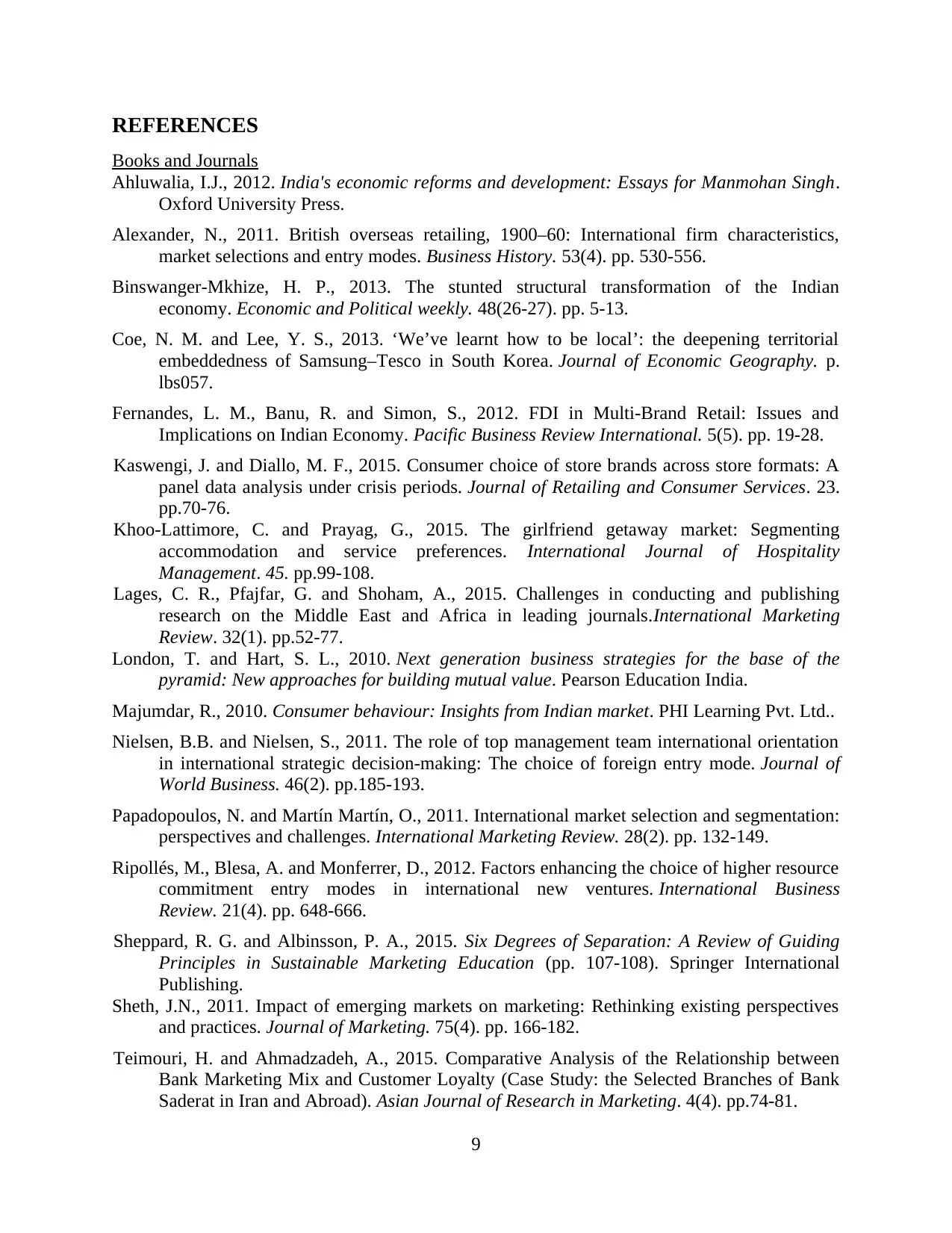
REFERENCES
Books and Journals
Ahluwalia, I.J., 2012. India's economic reforms and development: Essays for Manmohan Singh.
Oxford University Press.
Alexander, N., 2011. British overseas retailing, 1900–60: International firm characteristics,
market selections and entry modes. Business History. 53(4). pp. 530-556.
Binswanger-Mkhize, H. P., 2013. The stunted structural transformation of the Indian
economy. Economic and Political weekly. 48(26-27). pp. 5-13.
Coe, N. M. and Lee, Y. S., 2013. ‘We’ve learnt how to be local’: the deepening territorial
embeddedness of Samsung–Tesco in South Korea. Journal of Economic Geography. p.
lbs057.
Fernandes, L. M., Banu, R. and Simon, S., 2012. FDI in Multi-Brand Retail: Issues and
Implications on Indian Economy. Pacific Business Review International. 5(5). pp. 19-28.
Kaswengi, J. and Diallo, M. F., 2015. Consumer choice of store brands across store formats: A
panel data analysis under crisis periods. Journal of Retailing and Consumer Services. 23.
pp.70-76.
Khoo-Lattimore, C. and Prayag, G., 2015. The girlfriend getaway market: Segmenting
accommodation and service preferences. International Journal of Hospitality
Management. 45. pp.99-108.
Lages, C. R., Pfajfar, G. and Shoham, A., 2015. Challenges in conducting and publishing
research on the Middle East and Africa in leading journals.International Marketing
Review. 32(1). pp.52-77.
London, T. and Hart, S. L., 2010. Next generation business strategies for the base of the
pyramid: New approaches for building mutual value. Pearson Education India.
Majumdar, R., 2010. Consumer behaviour: Insights from Indian market. PHI Learning Pvt. Ltd..
Nielsen, B.B. and Nielsen, S., 2011. The role of top management team international orientation
in international strategic decision-making: The choice of foreign entry mode. Journal of
World Business. 46(2). pp.185-193.
Papadopoulos, N. and Martín Martín, O., 2011. International market selection and segmentation:
perspectives and challenges. International Marketing Review. 28(2). pp. 132-149.
Ripollés, M., Blesa, A. and Monferrer, D., 2012. Factors enhancing the choice of higher resource
commitment entry modes in international new ventures. International Business
Review. 21(4). pp. 648-666.
Sheppard, R. G. and Albinsson, P. A., 2015. Six Degrees of Separation: A Review of Guiding
Principles in Sustainable Marketing Education (pp. 107-108). Springer International
Publishing.
Sheth, J.N., 2011. Impact of emerging markets on marketing: Rethinking existing perspectives
and practices. Journal of Marketing. 75(4). pp. 166-182.
Teimouri, H. and Ahmadzadeh, A., 2015. Comparative Analysis of the Relationship between
Bank Marketing Mix and Customer Loyalty (Case Study: the Selected Branches of Bank
Saderat in Iran and Abroad). Asian Journal of Research in Marketing. 4(4). pp.74-81.
9
Books and Journals
Ahluwalia, I.J., 2012. India's economic reforms and development: Essays for Manmohan Singh.
Oxford University Press.
Alexander, N., 2011. British overseas retailing, 1900–60: International firm characteristics,
market selections and entry modes. Business History. 53(4). pp. 530-556.
Binswanger-Mkhize, H. P., 2013. The stunted structural transformation of the Indian
economy. Economic and Political weekly. 48(26-27). pp. 5-13.
Coe, N. M. and Lee, Y. S., 2013. ‘We’ve learnt how to be local’: the deepening territorial
embeddedness of Samsung–Tesco in South Korea. Journal of Economic Geography. p.
lbs057.
Fernandes, L. M., Banu, R. and Simon, S., 2012. FDI in Multi-Brand Retail: Issues and
Implications on Indian Economy. Pacific Business Review International. 5(5). pp. 19-28.
Kaswengi, J. and Diallo, M. F., 2015. Consumer choice of store brands across store formats: A
panel data analysis under crisis periods. Journal of Retailing and Consumer Services. 23.
pp.70-76.
Khoo-Lattimore, C. and Prayag, G., 2015. The girlfriend getaway market: Segmenting
accommodation and service preferences. International Journal of Hospitality
Management. 45. pp.99-108.
Lages, C. R., Pfajfar, G. and Shoham, A., 2015. Challenges in conducting and publishing
research on the Middle East and Africa in leading journals.International Marketing
Review. 32(1). pp.52-77.
London, T. and Hart, S. L., 2010. Next generation business strategies for the base of the
pyramid: New approaches for building mutual value. Pearson Education India.
Majumdar, R., 2010. Consumer behaviour: Insights from Indian market. PHI Learning Pvt. Ltd..
Nielsen, B.B. and Nielsen, S., 2011. The role of top management team international orientation
in international strategic decision-making: The choice of foreign entry mode. Journal of
World Business. 46(2). pp.185-193.
Papadopoulos, N. and Martín Martín, O., 2011. International market selection and segmentation:
perspectives and challenges. International Marketing Review. 28(2). pp. 132-149.
Ripollés, M., Blesa, A. and Monferrer, D., 2012. Factors enhancing the choice of higher resource
commitment entry modes in international new ventures. International Business
Review. 21(4). pp. 648-666.
Sheppard, R. G. and Albinsson, P. A., 2015. Six Degrees of Separation: A Review of Guiding
Principles in Sustainable Marketing Education (pp. 107-108). Springer International
Publishing.
Sheth, J.N., 2011. Impact of emerging markets on marketing: Rethinking existing perspectives
and practices. Journal of Marketing. 75(4). pp. 166-182.
Teimouri, H. and Ahmadzadeh, A., 2015. Comparative Analysis of the Relationship between
Bank Marketing Mix and Customer Loyalty (Case Study: the Selected Branches of Bank
Saderat in Iran and Abroad). Asian Journal of Research in Marketing. 4(4). pp.74-81.
9
⊘ This is a preview!⊘
Do you want full access?
Subscribe today to unlock all pages.

Trusted by 1+ million students worldwide
1 out of 13
Related Documents
Your All-in-One AI-Powered Toolkit for Academic Success.
+13062052269
info@desklib.com
Available 24*7 on WhatsApp / Email
![[object Object]](/_next/static/media/star-bottom.7253800d.svg)
Unlock your academic potential
Copyright © 2020–2025 A2Z Services. All Rights Reserved. Developed and managed by ZUCOL.



